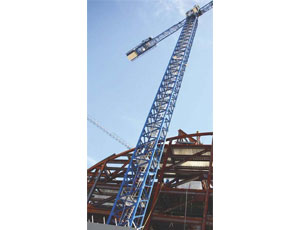Hanging more than 200 ft over a jobsite in downtown Kansas City, Mo., James Hague doesn’t seem to notice the tiny people and equipment below his feet. The senior technician is intently fiddling with a dial gauge that measures the amount of play in a crane turntable—the giant gear that rotates the jib. “A bearing could go bad,” says Hague, suspended from a full-body harness. “And that’s something we want to know before the top falls off.”
Although this vertigo-inducing procedure is not required by law for a routine inspection, it is standard practice at Kansas City, Mo.-based J.E. Dunn Logistics Inc., which is stepping up its safety program in an effort to cut risks—especially around hoisting equipment. After Hague performs an inspection for one of the company’s cranes, he climbs down, slips off his gloves, sits in his pickup truck and enters his findings in a smart phone or laptop. In seconds, the electronic report shoots off to a file server in the home office.
J.E. Dunn’s safety managers can then pull reports on the company’s fleet of 31 tower cranes, from anywhere in the U.S., using a secure Internet site. In the past, Hague and the firm’s other half-dozen inspectors would fill out a paper eventually filed away in a cabinet.
“I can tell you that we have had a very, very aggressive inspection program for years,” says Dan Euston, president of general contractor J.E. Dunn Construction, the logistic unit’s parent. “It’s just becoming more formalized and stringent as we’ve started sending more tower cranes around the country.”
After a spate of catastrophic crane accidents that rocked the construction industry in 2008, contractors like J.E. Dunn are boosting their quality checks—and trying to go above and beyond current safety standards around cranes. “We felt that that was an area of the industry that had risk,” Euston explains.
A large crane-rental company in Salem, Ore., is doing the same. There, Morrow Equipment Co., is putting its workers through a newly built, 9,000-sq-ft training center that it finished last summer. Among the classes are seminars on fall protection, rigging, lockout/tagout and electrical protection—fundamental training in areas that clients, regulators and insurers have tagged as risky. Nearby, at the company’s maintenance shop, a new system of red, blue and green stickers—which inspectors must sign and date—indicates whether or not crane parts are safe to go out into the field.
We visited both J.E. Dunn and Morrow this past fall to see firsthand how these firms are changing. Both companies are boosting quality assurance—the act of proving you did what you say you did. But is it enough? “We have to be diligent in maintaining our equipment and erecting equipment that we truly know—not that we believe—but that we truly know is safe,” says Peter Juhren, Morrow’s corporate service manager. “The accountability is the largest part of this new process.”
Kansas City is well known for blues, jazz and barbecue. But towering above the skyline, local residents also are quite familiar with J.E. Dunn’s fleet of royal-blue cranes, believed to be the largest general-contractor-owned tower crane fleet in the country. Made by Spain-based Linden Comansa, the iconic cranes have a signature “flat top” design, meaning that they use no overhead wires to support the jib.
“I think it’s a complete coincidence that the cranes are blue, and our company colors are blue,” says Cory Hall, safety manager at J.E. Dunn Logistics. “It’s just been a part of the culture.” What locals probably don’t notice, though, is the invisible database that now connects these cranes. The initiative began three years ago for general safety compliance and expanded last year for the hoisting fleet.
“In the past, when technicians go out to inspect a crane, they have a paper report that they fill out, and basically...



Post a comment to this article
Report Abusive Comment